Cannabis, Marijuana, Reefer, Pot. This plant goes by many names and has a rich and diverse history that many are unfamiliar with. We have compiled a little history of cannabis to help you better understand its long term relationship with Man.
The oldest record of cannabis dates back to China, circa 2900 BC. Emperor Fu Hsi, who is credited with bringing civilization to China, made reference to cannabis noting that it was a very popular medicine that “possessed both yin and yang” [7].
In Ancient Egypt, cannabis was a common prescription for treating eye diseases, inflammation, and pain in the uterus among other ailments. The mummy of Ramesses II, who died in 1213 BC, was found covered in cannabis pollen. [2].
In India, circa 1000 BC, cannabis was mixed with milk to create a drink called Bhang, which was used to treat a wide variety of human maladies [3]. Even in Ancient Greece, circa 200 BC, cannabis was used as a remedy for inflammation, edema, and earaches [3].
Emperor Fu Hsi
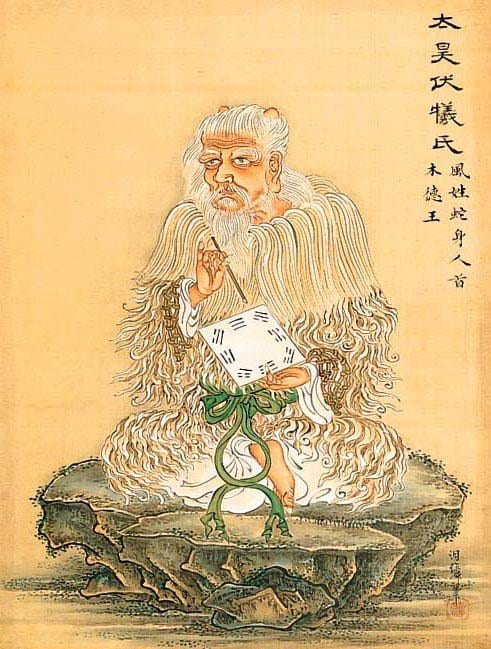
By 1 AD, cannabis had become a widespread medicine. In an ancient Chinese text compiled of drug recipes based on thousand-year-old traditions, cannabis was recommended for more than a hundred ailments including gout, malaria, rheumatism, and absent-mindedness [1].
70 years later, a Greek physician, Pedanius Dioscorides, who worked as a Roman army doctor published a book titled De Materia Medica (On Medical Matters) based on the plants he studied on campaigns throughout the empire. This would become the most important medical tome of the next 1500 years [4]. In it, he described cannabis as a pain reliever, alleviating earaches, with anti-inflammatory properties.
Many notable figures from history partook in the consumption of cannabis, including the prolific 17th-century writer, William Shakespeare. A study in the South African Journal of Science examined 24 pipe fragments excavated from Shakespeare’s garden and found cannabis in 8 of the samples [5].
This was around the same time that the Spanish brought cannabis to the Americas. The Jamestown settlers actually brought cannabis with them to Jamestown in 1611 and it became a booming commercial crop alongside tobacco [6].
Mount Vernon (George Washington's Plantation)

Our founding fathers also took part in the cannabis/hemp trade. The diary entries of George Washington indicate that he was growing hemp at Mount Vernon, his plantation, for 30 years [7]. He even divulged that he had a particular interest in its medicinal uses, and indicated that he was growing a high THC content cannabis. Even Thomas Jefferson noted in his diaries that he too grew hemp from 1774 – 1824 but did not mention his use of the plant, nor his use of tobacco and other substances [8]. Though he did indicate that he separated the male and female plants which is indicative of recreational use.
Pharmacopia, 1851
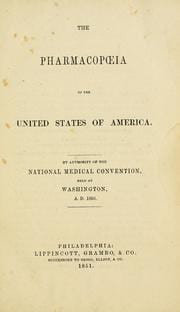
By 1850, the US Pharmacopeia [an official public standards-setting authority for all prescription and over-the-counter medicines] had included cannabis as a treatment for numerous afflictions including cholera, rabies, alcoholism, opiate addiction, leprosy, gout, convulsions, insanity, menstrual cramps, and more [9]. This was generally administered orally through an alcohol-based tincture and could be found in local drugstores.
In 1889, an article in The Lancet (one of the oldest and leading peer-reviewed medical journals) by Dr. E.A. Birch, outlined the use of cannabis in the treatment of opium withdrawal symptoms including cravings, nausea, and vomiting [4].
In 1906, Roosevelt signed the Pure Food and Drugs Act (also known as the Wyley Act) which requires the labeling of medicine with the proportions of any alcohol, morphine, opium, cocaine, heroin, alpha or beta eucaine, chloroform, cannabis indica, chloral hydrate, or acetanilide, or any derivative contained within [10]. A mere 5 years later in 1911 with the rise of prohibitionist sentiment in America, Massachusetts became the first state to outlaw cannabis [11]. Several states followed suit over the next few years including Colorado in 1917.
During the Great Depression of the 1930s, massive unemployment rates created public resentment and fear of Mexican immigrants. This created both public and governmental concern about the problem of Mexican cannabis, also known as marijuana. This instigated research which linked the use of “marihuana” with violence, crime, and other socially deviant behaviors with a focus on marginalized communities, and by 1931 twenty-nine states had outlawed marijuana [15].
Although, at the same time, the demand for cannabis-based medications was increasing and at least two American companies were selling extracts of cannabis for use as an analgesic, antispasmodic and sedative [1].
American Made Cannabis Extract
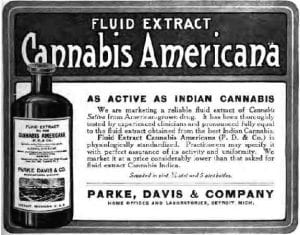
By 1933 cannabis, or as it was now being called “marijuana”, was a target of the government. One of the biggest opponents to the cannabis industry was William R. Hearst, owner of some 28 newspapers by the mid-1920s, who published sensationalistic stories that linked violent acts to the consumption of cannabis. He dropped the words cannabis and hemp, in favor of the term marijuana. Many believe that this was due to his financial interests in the lumber and paper industries and wanted to eliminate hemp from the competition [17 & 18].
Reefer Madness
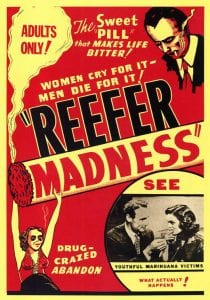
In 1936, the Bureau of Narcotics issued a report headlined “Traffic in Opium and Other Dangerous Drugs” in which they urged the Federal government to control marijuana, describing dire mental and moral changes amongst users [12].
That same year the (now) cult classic film, Reefer Madness, began as a church-funded film that was picked up and released (with flashier scenes added). The film spun a tale of how addiction to reefer (cannabis) ruins the life of the young protagonist with violence, promiscuity, and insanity.
At the last hearing on the proposed taxation of marijuana in May of 1937, Dr. William C. Woodward, legislative counsel of the American Medical Association (AMA), was the final witness to be heard. He announced his opposition to the bill and tried to dispel any notion that the AMA or any other enlightened medical opinion sponsored it [12]. Yet in October of that year, the federal Marijuana Tax Act was signed into law and banned its use and sales. The first men to be convicted under this law were 58-year-old Samuel Caldwell and his customer Moses Baca, 26, in Denver, Colorado [13]. And in 1942, cannabis was removed from the US Pharmacopeia [14]. Over the next few decades, laws only got stricter on marijuana use.
In response to the very public rise in cannabis consumption in the 60s, the Controlled Substances Act of 1970 was enacted. Thus the 5 Schedulings of substances that we know today was born. Marijuana was placed in Schedule I, which is “classified as having a high potential for abuse, no currently accepted medical use in treatment in the United States, and a lack of accepted safety for use of the drug or other substance under medical supervision.” [16] That same year the National Organization for the Reform of Marijuana Laws (or NORML) was founded as a nonprofit.
In June of 1971, President Nixon declared the War on Drugs that over time proved to be a failed effort. The following year a bipartisan commission, appointed by Nixon, considered the laws regarding marijuana and to determined that personal use should be decriminalized [15]. Although Nixon disregarded the recommendation, 11 states decriminalized and many others reduced penalties. The Drug Enforcement Agency (DEA) was established a few years later in 1973.
President Nixon
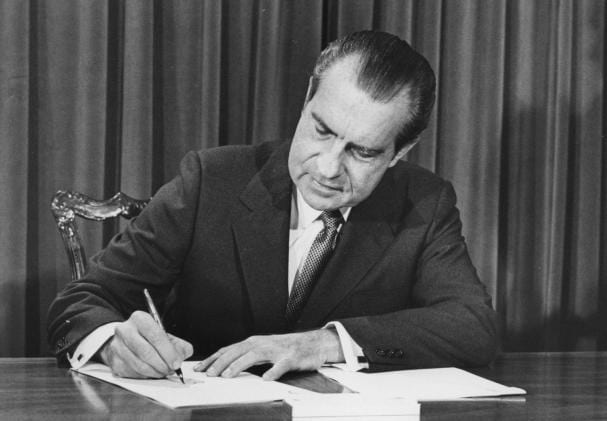
Reagan followed suit in 1984 with the signing of the Anti-Drug Abuse Act which instituted mandatory sentencing for drug-related crimes. A later amendment to the Anti-Drug Abuse Act established a “three strikes and you’re out” policy, requiring life sentences for repeat drug offenders, and providing for the death penalty for “drug kingpins” [23]. This was arguably one of the darkest times for cannabis consumers.
Prop 215 voters in California

The first glimmer of hope struck in 1991, when the first medical marijuana initiative passed with 79% of the vote in San Francisco, California [9]. Then in 1996, California became the first state to put medical marijuana laws into effect with the passing of Proposition 215.
The ball kept rolling with Alaska, Oregon, and Washington passing similar laws in 1998. Colorado joined in 2000, and by 2003 the US Department of Health and Human Services receives a patent (US 6,630,507 B1) for the therapeutic use of “cannabinoids as antioxidants and neuroprotectants.” Then in 2014, Colorado became the first state to legally sell cannabis to anyone over the age of 21 which was a monumental step for the legalization movement.
Today, 33 states have passed medical marijuana laws, and 10 states have passed adult-use, laws. We hope that more states will follow in Colorado’s footsteps and make this plant accessible to the population nation wide.
Continue your education on the different types of cannabis in our next blog, A Little Lesson on Sativa, Indica & Hybrids
For a deeper dive into the cannabis plant, its various compounds and the industry that surrounds it, call and book your private educational experience with City Sessions today. 720-250-8828
Sources
- Marijuana as Medicine: Beyond the Controversy, 2001
- An Ancient Egyptian Herbal, 1989
- “Marihuana, A Signal of Misunderstanding,” druglibrary.org, 1972
- Cannabis: A History, 2005
- South African Journal of Science, July 2015
- Perspectives on Drug Use in the United States, 1986
- Hemp American History Revisited: The Plant with a Divided History, 2003
- Spurious Quotations,” Monticello.org
- Medical Marijuana Law, 2007
- “FDA History – Part I,” FDA website (accessed Dec. 28, 2011)
- “The Forgotten Origins of Cannabis Prohibition in California,” Contemporary Drug Problems, Summer 1999
- “The Federal Prohibition of Marihuana,” Journal of Social History, Autumn 1970
- “The First Pot POW,” norml.org (accessed Feb. 21, 2012)
- “Report 10 of the Council on Scientific Affairs,” 1997
- “Busted: America’s War on Marijuana,” www.pbs.org (accessed July 21, 2010)
- “A Tradition of Excellence: The History of the DEA from 1973-2003,” DEA website (accessed Aug. 9, 2010)
